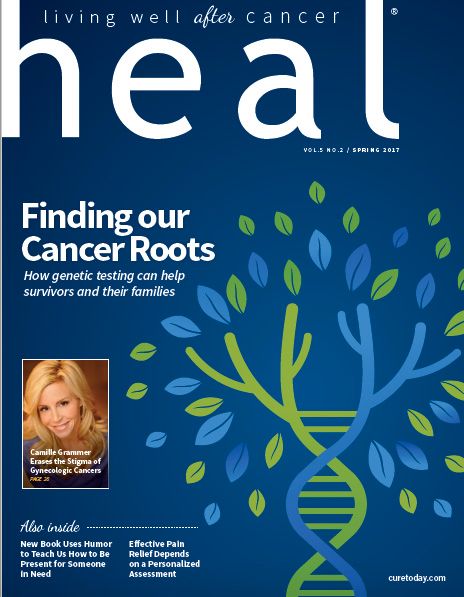Publication
Article
Heal
Is Your Oncology Nurse Listening?
Author(s):
Effective pain relief in cancer care depends on a personalized assessment.
With all of the stress and symptoms that come with a cancer diagnosis, unrelieved pain should not be one of them. A standard practice for nurses is to ask patients to “rate their pain” on a scale of 1 to 10, but experts say these assessments need to be much more nuanced and individualized to offer patients the best possible relief.
For patients this means making sure your nurse asks the right questions and understands that other underlying complaints like depression and anxiety go hand-in-hand with hard-to-manage pain. Relieving one may go a long way in alleviating the other.
“We know that pain is a significant problem for patients with cancer and happens throughout the cancer trajectory,” said Jeannine Brant, Ph.D., APRN, AOCN, FAAN, an oncology clinical nurse specialist, pain consultant and nurse scientist at the Billings Clinic Cancer Center in Montana.
In an interview with Heal ® and during her presentation at the recent 34th Annual Chemotherapy Foundation Symposium™, Brant stressed the critical importance of conducting a full pain assessment rooted squarely in the patient’s experience.
“One of the challenges in pain management is that nobody owns it. The physicians are very busy — they’re diagnosing and treating the cancer and ordering chemotherapy and looking for complications,” she said. But the good news is that nurses have stepped into that breach, and they are well positioned to do so even more frequently.
“Both nurses at the bedside and advanced practitioners are taking on greater roles in clinics, providing palliative care and staying focused on the human response to illness, such as pain, anxiety, sleep disturbance and fatigue. It’s all of those symptoms that can really cluster together and affect the patient’s quality of life,” Brant noted.
“This is the nurse’s primary responsibility. We can work collaboratively as a team, with physicians, to really try to solve patients’ pain problems.”
The Therapeutic Alliance
“The pain assessment is the best thing we can do to help patients to manage their pain,” said Brant, and the patient interview is the most important part of the process. She recommends that nurses work to establish a therapeutic relationship and “really focus on our own nonverbal behaviors, as well as the patient’s.”
The heightened attention on curbing opioid abuse in the United States, including the Food and Drug Administration’s move last summer to require stronger boxed warnings on prescription opioid analgesics, means that nurses have to sometimes perform a balancing act: They must be attuned to behaviors suggesting substance abuse, while still provide patients in pain access to effective and appropriate pain management.
“We have to remember that patients with cancer are different than patients with chronic, nonmalignant pain,” Brant stressed. “Preventing that pain is important to their quality of life. These patients will use opioids, and they may use them at high doses. On the other hand, we do have patients with substance abuse disorders.”
Nonetheless, “if we start out in a judgmental fashion, the patient is already going to be protecting themselves,” said Brant. “We need to focus on patients, address their fears and encourage them to talk openly, stressing that this is a therapeutic alliance.” Carefully and compassionately listening to patients and keeping an eye out for high-risk or aberrant behaviors that might signal a substance abuse disorder, such as “losing” a prescription or asking for an early refill, will go a long way in this effort.
A variety of pain syndromes exist in oncology practice, stemming not only from the cancer itself but also from the methods used to treat it. Skilled practitioners can assess the patient, identify the pain syndrome and then decide on the best approach. Actively engaging patients in their own pain management is important, said Brant.
“I definitely have patients who will say ‘You know what, I’m getting too sleepy, I don’t want to take the medication.’ So then we try to find ways to decrease the sedative effects of opioids and other modalities,” Brant pointed out.
Patient education is essential in this collaborative relationship, she added. Nurses should explain to patients how different medications work (e.g. long-acting versus breakthrough) and why they are used. “If nurses really partner with patients in developing the pain management plan,” Brant added, “that will help us to be more successful.”
Getting to the Root of the Problem
Assessing and managing cancer-related pain requires a team effort and a multimodal approach. The roots of patient pain are varied and complex, involving physical processes and psychological components. Although medication can be a critical part of the pain management toolkit, Brant said that it is important to be aware of any underlying psychological issues that may be in play.
“We know that psychological and emotional well-being has a lot to do with how people perceive pain,” said Brant, whose current research is exploring possible links between adverse childhood experiences (ACEs) and how patients cope with pain. In some, ACEs may cause “maladaptive coping or a lack of coping strategies that may lead to worse pain,” she explained.
Early traumatic experiences can also affect a patient’s resilience level, she continued. “We really want to look at where that patient is coming from. Do they have a family history of substance use disorder? Do they have a history of depression or anxiety?” Often, Brant said, “If we manage the pain, it can help manage the depression and anxiety, and vice versa.” Although this can be done with medication, she added that counseling, sitting at the bedside and simply listening to patient stories, can also be very helpful.
Ultimately, each patient’s experience of pain is an individualized one. Supporting that patient requires a team approach, and above all, said Brant, “really listening.”






